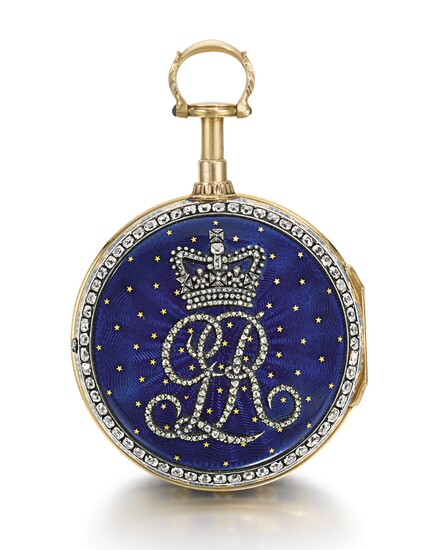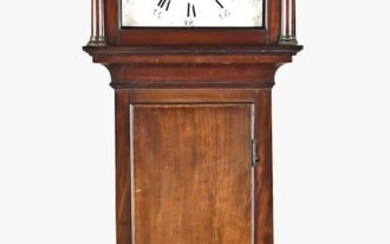Justin Vulliamy
YELLOW GOLD ENAMEL AND DIAMOND-SET DUMB QUARTER REPEATING CYLINDER WATCH CODE OMC CIRCA 1768
Justin Vulliamy
Dial: white enamel, Roman numerals and outer Arabic five minute chapter ring, diamond-set skeletonised cross-over style hands
Movement: fusée, cylinder escapement, plain steel 3-arm balance, diamond end-stone, balance cock engraved with mask and foliate scrolls, 2 hammers striking on the dust cap
Case: 18ct yellow gold, restored translucent blue enamel back with gold stars over engine-turned ground, decorative enamel blue and white enamel bands, applied diamond-set Royal Coronet and Cipher, “GR" on reverse, plunge repeat through the bow
Dimensions: 50.5mm diameter
Signed: movement signed Justin Vulliamy, datecode OMC
Accessories: none
Provenance:
Justin Vulliamy was the patriarch of three generations of watch and clockmakers. He left Switzerland and moved to England becoming the partner of Benjamin Gray, whose daughter he married. Following his father-in-law's death, Vulliamy continued to employ Gray's coded numbering system, which is still not fully understood. It is known that the coding system moved from 3 letters to four letters around 1812.
This is one of a small number of watches in large cases covered in blue enamel and lavishly set with diamonds, which bear the crowned cypher of King George III (r.1760-1820). There are two currently in the British Royal Collection [Note 1], and two others which sound very similar were exhibited in a 'Royal Treasures' loan exhibition in 1937 [Note 2]. The cypher does not indicate that such watches were for the King's own use, but rather that they were royal gifts to friends and close personal acquaintances within the Court circle. For example, one of the two now in the Royal Collection is reputed to have been given by the King to the Earl of Courtown.
Like the present watch, the two watches in the Royal Collection originally contained movements by (François) Justin Vulliamy (1712-1797). The movement in the Courtown watch is now missing, but was almost certainly Justin Vulliamy ama, while the other movement is signed Justin Vulliamy rzr. It is interesting to note that these code numbers and that of the present watch indicate that the movements were made several years apart - c.1764 for ama, c.1768 for omc, and as late as c.1789 for rzr. This suggests that a number of these distinctive cases may have been made early in the reign of George III, and movements were subsequently inserted as required, and resized when necessary, as with the present watch. This was not an uncommon practice with particularly prized cases, and the surviving Vulliamy business papers record several such instances, as well as the reverse process of recasing earlier movements, though unfortunately they do not cover these royal watches.
The immigrant Swiss watchmaker Justin Vulliamy had previously been in business with his father-in-law Benjamin Gray, who had been King's Watchmaker to George II from 1742 until that King died in 1760. On Gray's own death in 1764, Vulliamy took full control of the firm, and although he himself never obtained the Royal Warrant as King's Watchmaker, probably because he was not naturalised and so remained ineligible for this Civil List post, he certainly maintained close links with the horologically-minded new king, George III, and the Royal Household. Indeed, he received a personal appointment as clockmaker to Queen Charlotte, while his son and partner Benjamin Vulliamy (1747-1811) received a warrant as King's Clockmaker in 1772, and was in due course to be succeeded in this post by his own son Benjamin Lewis Vulliamy (1780-1854), who retained the Royal Warrant under several sovereigns until his death in 1854.
With sincere thanks to Roger Smith for his kind assistance with the detailed research on this watch.
1) Royal Collection, Inventory numbers RCIN 43796-7 and RCIN 65350. They can be seen on the website of the Royal Collection Trust.
2) The watches exhibited in 1937 are noted in Cedric Jagger, Royal Clocks (London 1983), p. 307, nos. 501 and 513B. An enamel and diamond watch in the same exhibition, no. 258H, which was apparently given by George III to Lord Harcourt, may have been similar. Interestingly, the lender of no. 501 was Kenneth Clark Esq., quite possibly the famous art historian who was then Director of the National Gallery.
For a short account of the Vulliamy family of watch and clockmakers, see Roger Smith's article in the Oxford Dictionary of National Biography (Oxford 2004 - also available online).
View it on
Estimate
Time, Location
Auction House
YELLOW GOLD ENAMEL AND DIAMOND-SET DUMB QUARTER REPEATING CYLINDER WATCH CODE OMC CIRCA 1768
Justin Vulliamy
Dial: white enamel, Roman numerals and outer Arabic five minute chapter ring, diamond-set skeletonised cross-over style hands
Movement: fusée, cylinder escapement, plain steel 3-arm balance, diamond end-stone, balance cock engraved with mask and foliate scrolls, 2 hammers striking on the dust cap
Case: 18ct yellow gold, restored translucent blue enamel back with gold stars over engine-turned ground, decorative enamel blue and white enamel bands, applied diamond-set Royal Coronet and Cipher, “GR" on reverse, plunge repeat through the bow
Dimensions: 50.5mm diameter
Signed: movement signed Justin Vulliamy, datecode OMC
Accessories: none
Provenance:
Justin Vulliamy was the patriarch of three generations of watch and clockmakers. He left Switzerland and moved to England becoming the partner of Benjamin Gray, whose daughter he married. Following his father-in-law's death, Vulliamy continued to employ Gray's coded numbering system, which is still not fully understood. It is known that the coding system moved from 3 letters to four letters around 1812.
This is one of a small number of watches in large cases covered in blue enamel and lavishly set with diamonds, which bear the crowned cypher of King George III (r.1760-1820). There are two currently in the British Royal Collection [Note 1], and two others which sound very similar were exhibited in a 'Royal Treasures' loan exhibition in 1937 [Note 2]. The cypher does not indicate that such watches were for the King's own use, but rather that they were royal gifts to friends and close personal acquaintances within the Court circle. For example, one of the two now in the Royal Collection is reputed to have been given by the King to the Earl of Courtown.
Like the present watch, the two watches in the Royal Collection originally contained movements by (François) Justin Vulliamy (1712-1797). The movement in the Courtown watch is now missing, but was almost certainly Justin Vulliamy ama, while the other movement is signed Justin Vulliamy rzr. It is interesting to note that these code numbers and that of the present watch indicate that the movements were made several years apart - c.1764 for ama, c.1768 for omc, and as late as c.1789 for rzr. This suggests that a number of these distinctive cases may have been made early in the reign of George III, and movements were subsequently inserted as required, and resized when necessary, as with the present watch. This was not an uncommon practice with particularly prized cases, and the surviving Vulliamy business papers record several such instances, as well as the reverse process of recasing earlier movements, though unfortunately they do not cover these royal watches.
The immigrant Swiss watchmaker Justin Vulliamy had previously been in business with his father-in-law Benjamin Gray, who had been King's Watchmaker to George II from 1742 until that King died in 1760. On Gray's own death in 1764, Vulliamy took full control of the firm, and although he himself never obtained the Royal Warrant as King's Watchmaker, probably because he was not naturalised and so remained ineligible for this Civil List post, he certainly maintained close links with the horologically-minded new king, George III, and the Royal Household. Indeed, he received a personal appointment as clockmaker to Queen Charlotte, while his son and partner Benjamin Vulliamy (1747-1811) received a warrant as King's Clockmaker in 1772, and was in due course to be succeeded in this post by his own son Benjamin Lewis Vulliamy (1780-1854), who retained the Royal Warrant under several sovereigns until his death in 1854.
With sincere thanks to Roger Smith for his kind assistance with the detailed research on this watch.
1) Royal Collection, Inventory numbers RCIN 43796-7 and RCIN 65350. They can be seen on the website of the Royal Collection Trust.
2) The watches exhibited in 1937 are noted in Cedric Jagger, Royal Clocks (London 1983), p. 307, nos. 501 and 513B. An enamel and diamond watch in the same exhibition, no. 258H, which was apparently given by George III to Lord Harcourt, may have been similar. Interestingly, the lender of no. 501 was Kenneth Clark Esq., quite possibly the famous art historian who was then Director of the National Gallery.
For a short account of the Vulliamy family of watch and clockmakers, see Roger Smith's article in the Oxford Dictionary of National Biography (Oxford 2004 - also available online).




